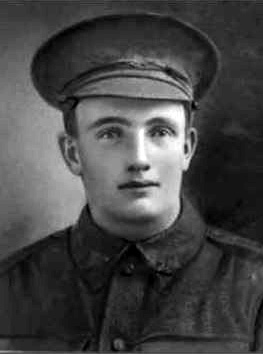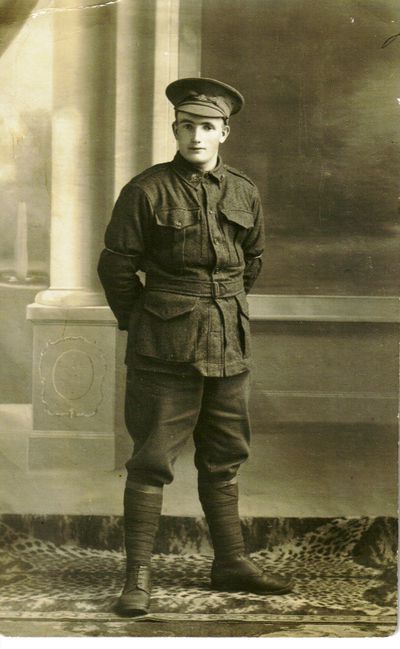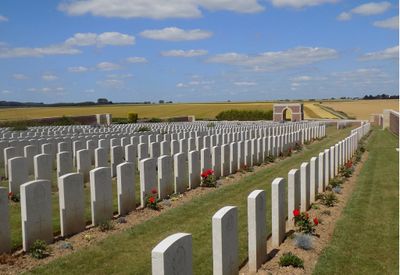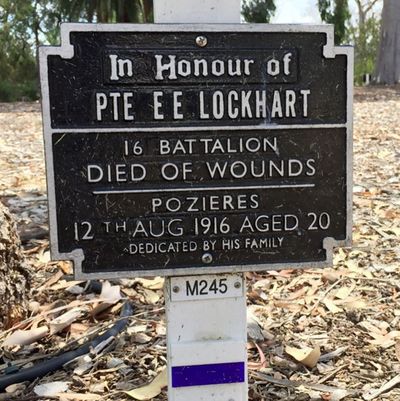Difference between revisions of "Ernest Edward Lockhart"
From Our Contribution
(→External Links) |
|||
| (3 intermediate revisions by the same user not shown) | |||
| Line 62: | Line 62: | ||
==Pre War== | ==Pre War== | ||
| − | + | Ernest Edward Lockhart was born in May 1896 at Blakeville, Victoria to John Charles Elsworthy and Rosanna Lockhart. He had a brother, Charles who also lost his life during WW1, and there were also five sisters in the family. The family moved from Victoria to Western Australia in 1902 and after a short stay in Leederville, settled in Astley Street, Gosnells and attended Gosnells state school. Ernest, after leaving school worked as a labourer. | |
==War Service== | ==War Service== | ||
| − | Ernest enlisted in Pinjarra, and entered camp on 23 Jun 1915 and was allocated to the 8th reinforcement draft for the 16th Battalion, travelling with them to Egypt | + | Ernest enlisted in Pinjarra, and entered camp on 23 Jun 1915 and was allocated to the 8th reinforcement draft for the 16th Battalion, travelling with them to Egypt aboard [[HMAT A68 Anchises]]. |
| − | On 18 Oct 1915 Ernest boarded [[HMT Kalyan]] in Alexandria for Mudros Harbour where he disembarked on 22 Oct 1915 and was taken on strength by the 16th Battalion the next day. The | + | On 18 Oct 1915 Ernest boarded [[HMT Kalyan]] in Alexandria for Mudros Harbour where he disembarked on 22 Oct 1915 and was taken on strength by the [[16th Battalion]] the next day, allocated to 'A' Company. The 16h Battalion's rest period at Mudross was now over and they returned to Gallipoli via a weather enforced lay over on Imbros where they transferred to barges, eventually reaching the Gallipoli beach on 2 Nov 1915. They were to spend the rest of their time at Gallipoli manning the line on Aghyl Dere. Ernest was in the second group of the battalion that evacuated Gallipoli on December 20th around 2am. The 16th Battalion was transported by lighters to [[HMS Mars]] which conveyed them to Lemnos where they disembarked on 21 Dec 1915. On 26 Dec 1915 the battalion boarded [[HMAT A11 Ascanius]] for the return trip to Alexandria, which sailed from Mudros Harbour on 27 Dec 1915, and arriving in Alexandria on 30 Dec 1915. |
| − | Back in Egypt, on 27 Feb 1916 he was seen by the 4th | + | Back in Egypt, on 27 Feb 1916 he was seen by the [[4th Field Ambulance]] suffering with influenza and was transferred to the New Zealand Auxiliary Hospital in Ismailia. Discharged on 3 Mar 1916 he rejoined the battalion the same day. On 1 Jun 1916, along with his unit Ernest boarded [[HMT Canada]] in Alexandria Harbour for Marseilles in France, arriving there and disembarking on 9 Jun 1916. They travelled by train to northern France. |
| − | At 7:00pm, on 9 Aug 1916 the 16th Battalion moved into the front line in preparation | + | At 7:00pm, on 9 Aug 1916 the 16th Battalion moved into the front line in preparation for an attack on Pozières. Their particular task was to capture Circular Trench that lay between Pozières and Mouquet Farm. The attack was launched at midnight and was a great success with all objectives taken. The enemy responded with a very heavy artillery bombardment, and during the bombardment on 10 Aug 1916, Ernest received a very serious penetrating shrapnel wound to the head. Evacuated to the [[3rd Australian Casualty Clearing Station]] on 11 Aug 1916, he died from his wound the following day. |
<div><ul> | <div><ul> | ||
| Line 95: | Line 95: | ||
[[Category:Methodist]] | [[Category:Methodist]] | ||
[[Category:Labourer]] | [[Category:Labourer]] | ||
| − | |||
| − | |||
[[Category:1916 WIA]] | [[Category:1916 WIA]] | ||
[[Category:1916 Deaths]] | [[Category:1916 Deaths]] | ||
Latest revision as of 14:52, 9 July 2022
 | |
 31 August 1915 courtesy Elaine de Ruiter | |
| Personal Information | |
|---|---|
| Date of Birth | c1896 |
| Place of Birth | Blakeville, Victoria |
| Death | 12 Aug 1916 |
| Place of Death | 3rd Australian Casualty Clearing Station Puchevillers |
| Age at Enlistment | 19 years, 1 month |
| Description |
5'5½" (1.66m) tall ; 155lbs 70.307 kg ; fair complexion ; grey eyes ; fair hair |
| Occupation | Labourer |
| Religion | Methodist |
| Address | Gosnells, Western Australia |
| Next of Kin | Father , Mr Charles Lockhart |
| Military Information | |
| Reg Number | 2676 |
| Date of Enlistment | 23 Jun 1915 |
| Rank | Private |
| Unit/Formation | 16th Battalion, 8th Reinforcement |
| Date of Embarkation | 2 Sep 1915 ‒ ? Sep 1915 |
| Ship Embarked On | HMAT A68 Anchises |
| Fate |
WIA 10 Aug 1916 Pozières DOW 12 Aug 1916 Puchevillers |
| Monument |
Gosnells War Memorial Gosnells Road Board Honour Roll Gosnells Primary School Honour Roll Gosnells Ward Honour Roll Australian War Memorial |
| Medals |
1914-15 Star British War Medal Victory Medal |
Contents
Pre War
Ernest Edward Lockhart was born in May 1896 at Blakeville, Victoria to John Charles Elsworthy and Rosanna Lockhart. He had a brother, Charles who also lost his life during WW1, and there were also five sisters in the family. The family moved from Victoria to Western Australia in 1902 and after a short stay in Leederville, settled in Astley Street, Gosnells and attended Gosnells state school. Ernest, after leaving school worked as a labourer.
War Service
Ernest enlisted in Pinjarra, and entered camp on 23 Jun 1915 and was allocated to the 8th reinforcement draft for the 16th Battalion, travelling with them to Egypt aboard HMAT A68 Anchises.
On 18 Oct 1915 Ernest boarded HMT Kalyan in Alexandria for Mudros Harbour where he disembarked on 22 Oct 1915 and was taken on strength by the 16th Battalion the next day, allocated to 'A' Company. The 16h Battalion's rest period at Mudross was now over and they returned to Gallipoli via a weather enforced lay over on Imbros where they transferred to barges, eventually reaching the Gallipoli beach on 2 Nov 1915. They were to spend the rest of their time at Gallipoli manning the line on Aghyl Dere. Ernest was in the second group of the battalion that evacuated Gallipoli on December 20th around 2am. The 16th Battalion was transported by lighters to HMS Mars which conveyed them to Lemnos where they disembarked on 21 Dec 1915. On 26 Dec 1915 the battalion boarded HMAT A11 Ascanius for the return trip to Alexandria, which sailed from Mudros Harbour on 27 Dec 1915, and arriving in Alexandria on 30 Dec 1915.
Back in Egypt, on 27 Feb 1916 he was seen by the 4th Field Ambulance suffering with influenza and was transferred to the New Zealand Auxiliary Hospital in Ismailia. Discharged on 3 Mar 1916 he rejoined the battalion the same day. On 1 Jun 1916, along with his unit Ernest boarded HMT Canada in Alexandria Harbour for Marseilles in France, arriving there and disembarking on 9 Jun 1916. They travelled by train to northern France.
At 7:00pm, on 9 Aug 1916 the 16th Battalion moved into the front line in preparation for an attack on Pozières. Their particular task was to capture Circular Trench that lay between Pozières and Mouquet Farm. The attack was launched at midnight and was a great success with all objectives taken. The enemy responded with a very heavy artillery bombardment, and during the bombardment on 10 Aug 1916, Ernest received a very serious penetrating shrapnel wound to the head. Evacuated to the 3rd Australian Casualty Clearing Station on 11 Aug 1916, he died from his wound the following day.
Notes
Ernest's parents received a telegram from Military officials on 8 Sep 1916 advising that he was wounded (27 days after he had died, and 29 days after he was wounded).


